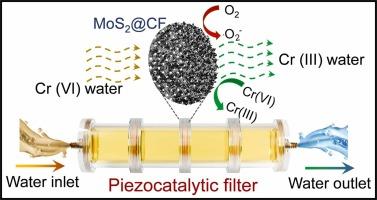Low-frequency hydromechanical energy triggered piezocatalytic activity of MoS2 nanosheets for sustainable removal of Cr (VI)
IF 17.1
1区 材料科学
Q1 CHEMISTRY, PHYSICAL
引用次数: 0
Abstract
Piezocatalysis is an emerging technology where a piezoelectric material under mechanical stress in water produces reactive oxygen species (ROS) that are effectively utilized for environmental remediation applications. However, unavailability of high-power mechanical energy source like ultrasound in nature, restricts the wide-spread deployment of piezocatalysis for real-life applications. Herein, we demonstrate successful utilization of low-power hydromechanical energy for ROS generation and consequent reduction of Cr (VI) through MoS2 nanosheets based piezocatalyst. MoS2 nanosheets are grown on cotton fabric (MoS2@CF) via facile solvothermal method and further characterized by XRD, XPS, FESEM and HRTEM techniques. With the application of mechanical force, the developed MoS2 nanosheets based piezocatalyst exhibits high Cr (VI) reduction efficiency, achieving complete reduction of 100 ppm Cr (VI) in just 50 min. A piezocatalytic filter is designed with MoS2@CF for mimicking piezocatalysis under real-life low-frequency water flow. The designed piezocatalytic filter demonstrates almost 99 % reduction of Cr (VI) in 9 hrs at a flow rate of 2 L/min. Piezocatalytic Cr (VI) reduction activity has been elucidated in light of mechanical stress induced band bending and the free carrier separation phenomena. The undertaken strategy highlights the great potential of piezocatalysis technology for harnessing low-power mechanical energy source in nature for wastewater treatment.

低频水机械能触发MoS2纳米片持续去除Cr (VI)的压催化活性
压电催化是一项新兴技术,压电材料在水中受到机械应力产生活性氧(ROS),可有效地用于环境修复应用。然而,由于自然界中超声等大功率机械能的缺乏,限制了压电催化在实际应用中的广泛应用。在这里,我们成功地利用了低功率的流体机械能来产生ROS,并通过基于MoS2纳米片的压电催化剂来减少Cr (VI)。采用溶剂热法在棉织物(MoS2@CF)上生长二硫化钼纳米片,并用XRD、XPS、FESEM和HRTEM对其进行了表征。在机械力的作用下,基于MoS2纳米片的压电催化剂表现出较高的Cr (VI)还原效率,在50分钟内完全还原了100 ppm的Cr (VI)。利用MoS2@CF设计了一种用于模拟实际低频水流下的压电催化的压电催化过滤器。所设计的压催化过滤器在2 L/min的流速下,在9小时内可将Cr (VI)降低近99%。从机械应力诱导的带弯曲和自由载流子分离现象出发,阐明了压电催化Cr (VI)的还原活性。所采取的战略强调了压电催化技术在利用低功率机械能处理废水方面的巨大潜力。
本文章由计算机程序翻译,如有差异,请以英文原文为准。
求助全文
约1分钟内获得全文
求助全文
来源期刊

Nano Energy
CHEMISTRY, PHYSICAL-NANOSCIENCE & NANOTECHNOLOGY
CiteScore
30.30
自引率
7.40%
发文量
1207
审稿时长
23 days
期刊介绍:
Nano Energy is a multidisciplinary, rapid-publication forum of original peer-reviewed contributions on the science and engineering of nanomaterials and nanodevices used in all forms of energy harvesting, conversion, storage, utilization and policy. Through its mixture of articles, reviews, communications, research news, and information on key developments, Nano Energy provides a comprehensive coverage of this exciting and dynamic field which joins nanoscience and nanotechnology with energy science. The journal is relevant to all those who are interested in nanomaterials solutions to the energy problem.
Nano Energy publishes original experimental and theoretical research on all aspects of energy-related research which utilizes nanomaterials and nanotechnology. Manuscripts of four types are considered: review articles which inform readers of the latest research and advances in energy science; rapid communications which feature exciting research breakthroughs in the field; full-length articles which report comprehensive research developments; and news and opinions which comment on topical issues or express views on the developments in related fields.
 求助内容:
求助内容: 应助结果提醒方式:
应助结果提醒方式:


